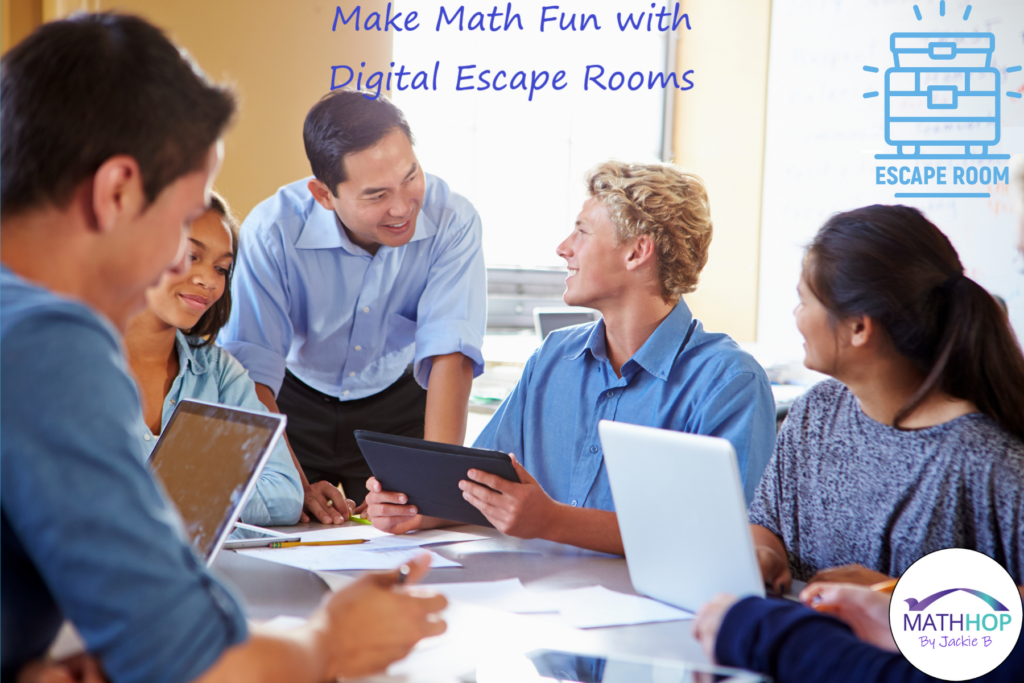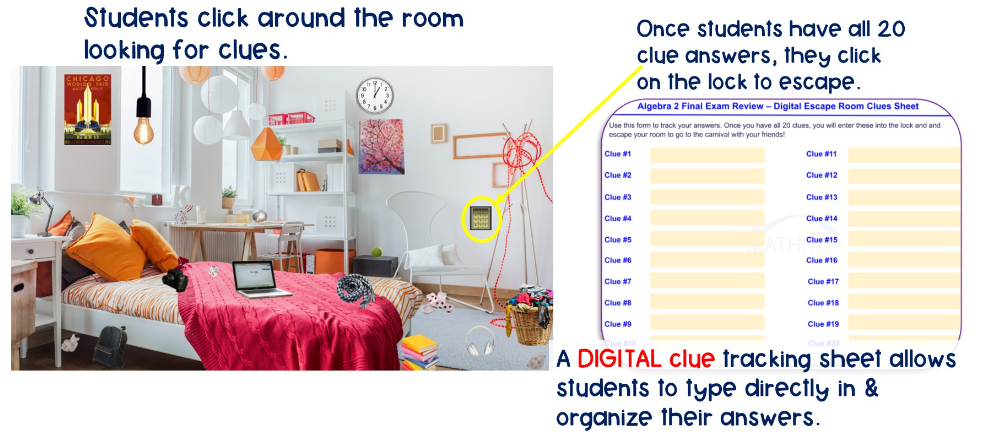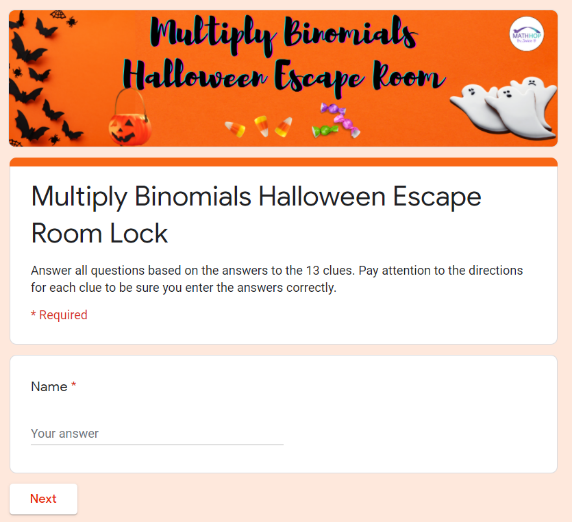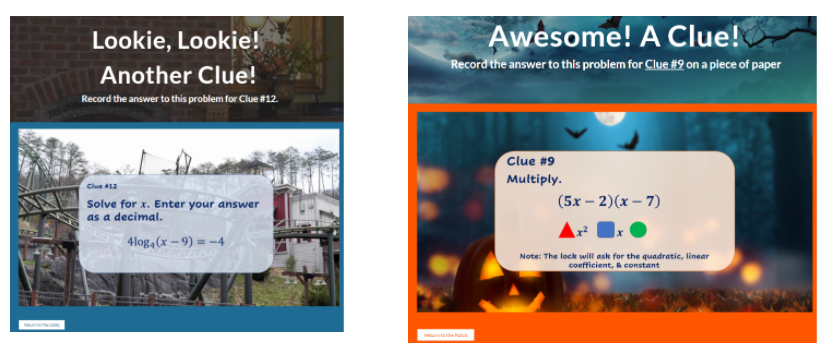
Let’s face it, getting students excited about and engaged in math is sometimes easier said than done. But it is also crucially important! Students engaged during math class increase their attention and focus, leading to a more meaningful classroom experience, making students more likely to see math as a subject they can succeed in. Students who no longer fear math go further and are more likely to take advanced courses like Precalculus and Calculus.
I have found that digital escape rooms really capture students’ attention and hold their interest. I used to set up physical escape rooms in my classroom with little safes and fake keys and prizes strewn about my classroom. But with the recent need for digital products, I pivoted to creating digital math escape rooms and students LOVE them. I mean ALL students. Even high school students love digital escape rooms. Some of my Calculus students’ absolute favorite activities are math digital escape rooms.
How do math escape rooms work?
Digital escape rooms involve no-prep, are self-grading, and they really increase student engagement and I find that they are best used for those concepts students tend to struggle with or that are essential skills. You know, concepts like factoring quadratic trinomials? I don’t know what it is about factoring quadratics that students hate, but they really, really do. Start class by mentioning that students are going to complete another factoring worksheet and you will hear the groans. But start class by telling students that they are going to have to factor quadratic trinomials to escape a digital escape room and they will look at you with intrigue and curiosity.
My list of essential (or “groan-inducing”) concepts:
Factoring (literally ANY type of factoring)
Solve systems of linear equations
Exponential growth & decay word problems
Permutation & combination word problems
Operations with complex numbers
What does your list look like? I am sure you could add even more topics to this list. When I think about using escape rooms, I just think about the concepts that, if I found a genie in a bottle, I would wish for my students to understand completely.
I also LOVE using themed digital escape rooms. Think about how many semester reviews or final exam reviews you make your math students take. Imagine replacing one more review packet with a cumulative semester or final exam review digital escape room. I also love Halloween themed digital escape rooms. Halloween is the first holiday of the new school year and students of ALL ages love Halloween. If you can combine Halloween with a groan-inducing mathematical concept – that is a win-win scenario for a digital escape room. I even use Halloween themed digital escape rooms for younger students that I tutor – enter 5th grade word problems (I think every student I ever met loathes word problems).

How to start with digital escape rooms?
Usually, digital escape rooms are made in one of two ways. The first way is with Google Slides and the second is housed on a Google Site. If you are just getting started with digital escape rooms, I suggest starting with Google Slides. When I say Google Slides, the bulk of your escape room will be in Google Slides but the lock (what students use to escape) will be used with a Google Form.
To start, open a new Google Slide and you will want to insert or create a background image. You can purchase a stock image or search sites like Canva or Pixabay for great images. I use my own images, so when I go on vacation I will take pictures of museums (without people in the image of course) or I like to go to the library when it first opens and get a picture of an empty library, or aisles of books, it all depends on the theme of my escape room.
Once you have your slide, you are going to create clickable images. This can be done by laying transparent shapes over images already in your room or by inserting new images. These will typically be smaller images in and around your background picture. In this picture (that I took from a museum) I made transparent shapes on top of things like buildings, the signs on the wall, cars, and added images like the fire alarm. So you start with something that looks just like a picture but has different clickable links in it.

Next, it is time to determine where all of your clickable images will go. These will serve as your clues. They can link to another slide in the presentation with a problem on it, they can go to a document with a set of problems or riddles on it, they can go to a video where they have to answer questions; where the links go and how complicated you make the clues is really up to you.
Now that you have your image and you have some pictures that will serve as your clickable links, you need a lock (which will be a Google form) for students to use to “escape”. In my picture, the small keypad is the lock. Students click on that, and it brings up a Google form where they input all of their answers. Students are told once they have found and solved all “x” clues, they must click on the keypad to bring up the lock and enter their answers to escape. See my lock below.

When building your lock, it is nice to include a final “Congratulations” question for when the students escape. Again, you can make this in Canva or Pixabay.

So that is a very high level of how you can create a digital escape room using Google slides. If you have questions, feel free to drop them in the comments below.
How to implement digital escape rooms
Whether your students are working independently on these digital escape rooms or in groups, online or in-person, digital math escape rooms foster deeper thinking, they are engaging, require no-prep and really get your students interested in and talking about your math class. Digital escape rooms can be built in Google slides with a Google form serving as the lock, but my FAVORITE escape rooms are housed on a Google site as they are seamless, contain no outside links, and function more like an actual escape room than those made in Google slides.
I have assigned digital escape rooms as homework and I have set up 2 computers in my room with an escape room, along with 3 other center stations allowing students to work in teams of 4 to compete against each other. How can you use these in your math class? This list recommends only a fraction of the ways these escape rooms can be implemented – you are only limited by your imagination.
⭐ Assign as homework
⭐ Use as a teamwork activity on computer lab days
⭐ Assign as an individual assignment on computer lab days
⭐ Set it up in the classroom as a center (on one or more computers)
⭐ Use it on a projector with kids in pairs, small teams, or a whole class activity
The only question left is, how will you use digital escape rooms in your math class?

